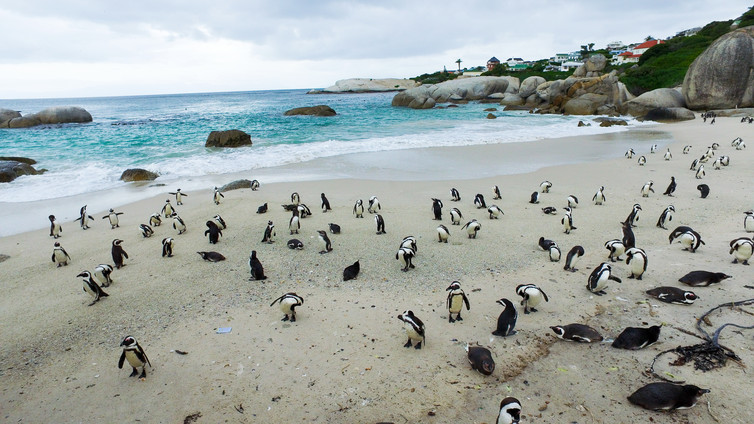
Young African Penguins Are Dying Because They Can’t Find the Fish They Need
When young African penguins leave their nests for the first time they do so alone, without any guidance from their parents. They need to use their instinct to follow cues in their environment to find food and stay alive in their first months at sea. Hard as that may have been in the past, today […]

When young African penguins leave their nests for the first time they do so alone, without any guidance from their parents. They need to use their instinct to follow cues in their environment to find food and stay alive in their first months at sea. Hard as that may have been in the past, today climate change and high fishing pressure have made it even more difficult. 

For penguins in South Africa and Namibia, abundant supplies of their favoured prey, such as sardine and anchovy, are no longer where the penguins expect to find them. This causes the young birds to fall into what is known as an ecological trap. This is when they follow the usual cues to feeding grounds only to find that the sources of food in these places is no longer available. This can be due to changes in stocks of particular foods due to over-fishing or underlying environmental change
African penguins are listed as endangered by the International Union for Conservation of Nature, as numbers along their entire range in South Africa and Namibia have dramatically decreased in the last century and trends currently don’t show any sign of reversing. In the last 50 years, the population has dropped by 80% and there are only about 23 000 breeding pairs in the wild.
In our new study, we followed 54 juvenile penguins – penguins who have lost their down feathers and are now waterproof and ready to go to sea – on their initial journey along the southern African coast using satellite transmitters.
Dwindling fish stocks
The birds moved to areas of the ocean where sea temperatures are low and productivity – in the form of the phytoplankton microscopic food that is the base of many aquatic food webs – is high. To do so, they travelled large distances to areas such as St. Helena Bay along the West Coast of South Africa and Swakopmund in central Namibia. Both are historically known for their high fish abundance.
But large fish stocks no longer exist in these areas. This is because of the combined effects of the changing climate and fishing pressure. Since the lower levels of the ecosystem have not been affected in the same way, the signals that the penguins would have always used to locate their prey are still intact.
For example the phytoplankton is still there and is still preyed upon by zooplankton, microscopic animals drifting in the ocean. But today, the fish that would normally co-occur with their planktonic prey are scarce or absent.
Juvenile penguins are “tricked” into selecting the now poor habitat and fall into this large-scale ecological trap. This previously unnoticed ecosystem-wide phenomena explains the low survival chances of this endangered species, especially during its first year at sea. It contributes to the dramatic decline of the penguin population.
Modelling exercises in the current study showed that with sufficient food in these areas, the African penguin population on the West Coast of South Africa would be twice the size it is now. There would be around 5,000 pairs at Dassen and Robben Islands, instead of only around 2,500. Only juvenile penguins from the Eastern Cape colonies, located in Algoa Bay, foraged in an area which provides sufficient food, the Agulhas Bank.

Escaping the trap?
Several conservation measures are being taken to halt the decline of the African penguin and a few could help get the penguins out of this ecological trap. Efforts to hand-raise chicks and create new penguin colonies may help bolster the population and build resilience against future change. The Southern African Foundation for the Conservation of Coastal Birds, South Africa’s largest rehabilitation centre, hand-rears several hundred chicks each year. This happens after they are abandoned in the colonies because their parents get oiled or injured, or simply cannot find enough food to raise them during the breeding season.
Once these birds reach fledgling age, they are released back into the wild. Fourteen of the penguins in this study were hand-reared and the results show that these chicks behave in the same way as counterparts raised by their parents. Unfortunately, these penguins also travel into areas with low food availability.
The chicks raised at the centre behave naturally once back in the wild and could be used as part of efforts to create new penguin colonies by releasing them at designated areas where they could found new colonies in closer proximity to the available food.
But a great deal more needs to be done to address the problem of the ecological trap. The study shows that large scale conservation measures – such as reduced fish quota or suspension of the fisheries once the fish population falls below critical ecological thresholds – are urgently needed to protect the endangered African penguin and other seabirds in the Benguela Current, a highly productive cold water system along the west coast of Southern Africa. These measures must go hand-in-hand with conservation initiatives that are in place already.
The ecological trap for African penguins was discovered by tracking juveniles. This is an age group about which very little is known in many seabird species. It highlights the importance of further studies on the survival strategies in the first year of particular seabirds’ life to understand the dynamics of species across their range.
Katrin Ludynia, Honorary Research Associate and Research Manager at SANCCOB, University of Cape Town and Richard Sherley, Research Fellow, Bristol Zoological Society and University of Exeter, University of Exeter
This article was originally published on The Conversation. Read the original article.